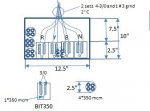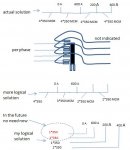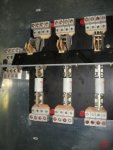Need a little help, I have a trough sizing question. I have a 8' long horizontal trough leaving the side of a 1200a service switch for future tenant panels and 2 that I will be installing. I believe I am interpreting the code correctly and want to make sure that I am.
The wireway will consist of 4 sets of 350mcm copper conductors extending from the switch through the trough. Off of that I will have a 400a and 200 tap. (400a panel tap will be made with 4-3/0 and 1 # 3 ground; 200a panel tap to trough will be made with 4-3/0 and 1 #6 ground)
Am I correct that I can use a 12"x12" trough? That seems small, If so I would likely upsize but I want to check with you guys on the code part first.
Article 366.56(a) states taps and splices are permitted with gutters where they are accessible by means of removable covers or doors. The conductors, including splices and taps, shall not fill the gutter to more than 75% of its area.
4-350's x 16
13- 3/0's
1#6
The Burndy UniTaps (BIBS350-8) I will be using are 7.68"x2.32"x2.50"
THERE ARE 2 ATTACHMENTS here both are the same file one is just a pdf vs. a png
Any help and direction that can be provided to help make sure I am interpreting correctly would be appreciated.
Thanks in advance,
EC
The wireway will consist of 4 sets of 350mcm copper conductors extending from the switch through the trough. Off of that I will have a 400a and 200 tap. (400a panel tap will be made with 4-3/0 and 1 # 3 ground; 200a panel tap to trough will be made with 4-3/0 and 1 #6 ground)
Am I correct that I can use a 12"x12" trough? That seems small, If so I would likely upsize but I want to check with you guys on the code part first.
Article 366.56(a) states taps and splices are permitted with gutters where they are accessible by means of removable covers or doors. The conductors, including splices and taps, shall not fill the gutter to more than 75% of its area.
4-350's x 16
13- 3/0's
1#6
The Burndy UniTaps (BIBS350-8) I will be using are 7.68"x2.32"x2.50"
THERE ARE 2 ATTACHMENTS here both are the same file one is just a pdf vs. a png
Any help and direction that can be provided to help make sure I am interpreting correctly would be appreciated.
Thanks in advance,
EC




